Esek
From Peace Dale to a Confederate Prison.
by Glenn Laxton
The following article is from Rhode Island: A Genial History, a collection of historical tales by Paul F. Eno and Glenn Laxton, where it appears under the title "From Peace Dale to a Confederate Prison." It originally appeared in Old Rhode Island magazine, March/April 1992, and is reprinted here with permission of the author.
The greatest battle ever fought upon this continent took place yesterday near Manassas Junction.
This report was published in the Providence Daily Journal on July 22, 1861. By then, 481 Union soldiers had been listed as killed, 1,011 wounded, and 1,120 missing or captured. Tragically, one Rhode Islander's name was to be listed under all three headings. It was a statistic of a war in which brother fought brother, and about which thousands of stories were to be written after being played out on battlefields in a young nation divided.
The "greatest battle" was the first one to take place at Manassas, Virginia, and it came to be known in the North as the First Battle of Bull Run. It was about 10 o'clock on the morning of July 21 when the Second Rhode Island Regiment became trapped in a wooded area a half mile west of the stream known as Bull Run, and three miles northeast of Manassas Junction. Within five minutes Confederate forces had inflicted most of the casualties and, after two hours of fighting, it was all over. Union troops had lost the battle.
Corporal Esek B. Smith of Peace Dale, age twenty-eight, father of five small children and husband of Lucy Webster Smith, already was on two of those lists: wounded and captured. In less than three weeks, he would be on the third and final list.
Smith was born in South Kingstown on May 19, 1833, and spent his entire life, up to his enlistment in the army, living there. Like many young men of that period, he was a laborer, and worked in the local mill in the Peace Dale section of town. He married Lucy Adeline Webster on November 9, 1851, at Queen's River Baptist Church in Usquepaugh, a hamlet of South Kingstown, in a ceremony performed by the Reverend Ezekiel J. Locke. Esek was eighteen and Lucy sixteen. By the time Smith was mustered into Company E of the Second Rhode Island Regiment of Volunteers, he and Lucy, (or Adeline as she was called), had been married for ten years and had five children aged nine years to eight months.
Esek worked as a weaver at the Peace Dale Woolen Company, and word of the war pitting North against South was everyday conversation during that spring of 1861. One day in May, the mill's overseer, Isaac Rodman, announced to his fellow workers that he was marching off to join the army. Hearing of Rodman's enlistment, and lured by the prospect of twelve dollars cash a month for some excitement, Smith and several other employees went to the Company E recruiter, who was in town, and joined up. Although they signed their names for a three year hitch, everyone knew the fighting would be over in a few weeks.
The recruiting officer asked Smith, "Are you in good shape?"
"Yes," replied Smith, who proved it by dancing around the room.
The physical examination complete, Smith was appointed a corporal, as the Second Rhode Island was wasting no time in getting ready for war.
On June 7, the full Second Rhode Island Regiment was paraded and reviewed at Exchange Place in Providence, a great distance from South Kingstown in a time before mass transportation. Smith said his goodbyes to his wife and children, and left them for what would be the last time. At Exchange Place, a focal point in the state's capital city, Smith and his colleagues heard a eulogy, read by the Secretary of War, in memory of Honorable Stephen A. Douglas, the distinguished senator who had run for president against Abraham Lincoln in 1860, and who had died on June 2.
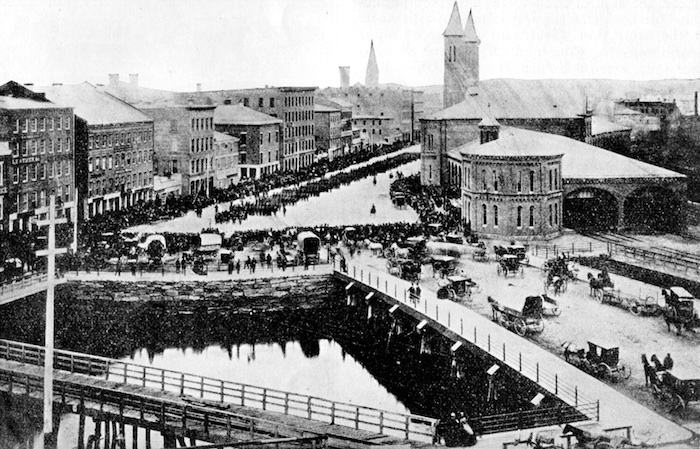
The following day, the Regiment set up camp at the Dexter Parade Ground, a mile-and-a-half west of Exchange Place, and by the 12th, under the command of Colonel John S. Rodman, the regiment was beginning to shape itself into a military organization. It was turning out to be a memorable time, as a group of patriotic ladies presented the regiment with U.S. and Rhode Island flags, which they had knitted in honor of these men, who were among the first to respond to Lincoln's call for troops, following the Confederate firing on Fort Sumter in Charlestown, South Carolina. Those who joined the call up of volunteers would no doubt sing the strains of the emotional tribute penned in their honor, "We Are Coming, Father Abraham, 300,000 strong."
But tributes and memories were far away in June 1861, when, on the 16th, the eloquent voice of the Right Reverend Thomas M. Clark boomed out over the congregation at Grace Church in Providence to those volunteers in attendance, instilling such inspiration in them that they would name their camp outside Washington, D.C., after him. Bishop Clark headed the Episcopal Diocese of Rhode Island, no doubt the highest ranking churchman most of the new troops had ever heard preach.
Rhode Island Governor William Sprague had been asked by the Secretary of War to send any volunteers to Washington, where headquarters would be established. On June 19, troops marched from the Dexter Parade Ground to Fox Point, a little over two miles away, where the steamships Killvon Kull and The State of Maine were waiting to take the Second Rhode Island Regiment, including Company E and Esek Smith, to war.
Slowly the vessels made their way to New York City, and then on to Elizabeth, New Jersey, where the troops disembarked and proceeded by train to Baltimore, Maryland. Marching through that city, they arrived in Washington late on the gray morning of June 22. It had been six days of non-stop travel by land, sea, and rail. When the Second arrived at its destination, the men were greeted by the First Rhode Island Regiment, and set up tents. The combined regiments were then placed under the command of Colonel Ambrose Burnside.
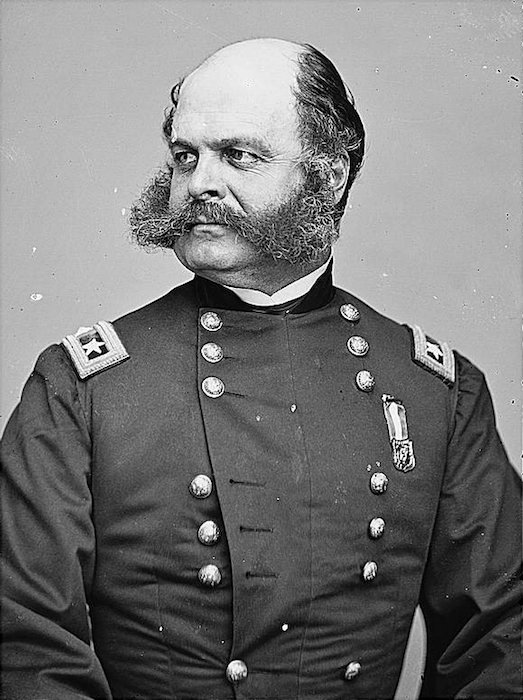
For veterans, life in what amounted to boot camp was monotonous, it was exciting and novel to the newly arrived soldiers. Days were spent in drills, parades, and prayer. There were inspections, reviews, and lessons in war and survival. The troops were becoming accustomed to a new way of living, and they were developing a new spirit of patriotism. Yet even the most bored of the "old timers" could not possibly know that, within days, their lives would end on a battlefield.
On July 8, troops camped in the Washington area were formed into five divisions. The Second Regiment was placed into what was called the Second Brigade, Second Division, commanded by Colonel David Hunter of the regular U.S. Army. To further confuse the newer soldiers, it was announced that the First and Second Rhode Island Regiments would remain under the immediate command of Colonel Burnside.
On July 16, the regiments met for the first time as a brigade, and marched down Pennsylvania Avenue and across Long Bridge into Virginia. That night they camped at Annandale and, early on the 17th, resumed marching toward the Southern army.
At 2am on the 21st, a delayed march began through a forest, where trees had to be cleared. At 9am the troops reached a good farm road near Sudley Springs, and they came upon residents walking to church in their best clothes. But this was a Sunday when there would be no service in the church. Instead, the little house of worship would soon be filled with the wounded and dying.


Colonel John Slocum climbed a rail fence bordering the corn field near the Matthews House just before 10am. Gunfire was nearby. As Slocum turned to give the command to proceed, bullets ripped into the back and side of his head. Falling mortally wounded, he was carried to Matthews House, where he died within minutes.
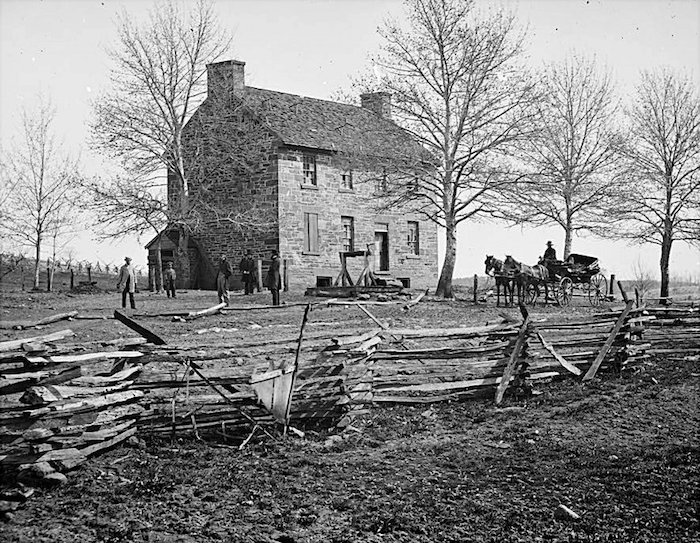
When Esek B. Smith joined Campany E. his twenty-two-year-old nephew William also enlisted. William saw Slocum fall. He did not see Esek fall, but minutes after Slocum's death, Esek's knee was shattered by Confederate fire.
William later wrote to his mother on Camp Clark stationery, "I am very sorry to say we can't give any account of Esic [sic]. Don't tell Adeline. I saw many of our regiment shot down. I was close to Slocum when he was killed. A hard time was had I tell you. The second regiment, that's the one we are in you know, stood 45 minutes in front of four regiments of rebels before any of the rest got up to us. I see Esic on the field afighting and have not seen him since after the fight. I looked everywhere for him but couldn't find him."
William would never see his uncle again. Although little documentation exists, it is likely the Confederates captured Esek, took him to Sudley Springs Methodist Church in Manassas and then to Libby Prison in Richmond, where Union prisoners of war were kept.

Libby eventually housed mostly officers, but with the first shots barely fired, Southern forces were not choosy about where they kept their prisoners. During four years of fighting, 125,000 Union soldiers were housed at various times at Libby -- one of the most notorious POW camps of the war. According to eyewitnesses, the first prisoners were not treated as poorly as tales of later incarcerations would describe. It is stated the first to be held at Libby were treated well, although they were deprived of newspapers, coffee, and sugar, and allowed no visitors.
That the early treatment was good can be attested to by the words of a Dr. Sternberg of the U.S. Army, who managed to escape capture at Manassas, and travel to safety through the thick woods. Sternberg learned that the prisoners at Libby were fed fresh boiled beef and wheat bread, with a small amount of rice every other day. Perhaps it wasn't a large amount of food, but it was enough to keep the less severely wounded, and those taken without injuries, alive.
Esek Smith was not slightly injured. He was seriously wounded, and without proper sanitation, he was doomed. Smith lingered at Libby until August 6 when, only six weeks after leaving his wife and young family, he died. Perhaps Rodman had told him and the others at the mill that the rebels would run when they heard the sound of gunfire. But Rodman was dead, too, and so was a young man named John Clark, also of Company E. All were part of that proud regiment that had encountered 2,000 Confederate troops, who did not run at the sound of gunfire during the First Battle of Bull Run.
Smith's widow, Adeline, received three months' wages as bounty for her husband's death.
Esek's monument stands at Oak Dell Cemetery in Peace Dale, not far from the mill where he worked and the small farm where he lived. It cannot be determined if his body is actually under the stone because recordkeeping was not good in the early, hectic days of the Civil War.
ESIC B.
SON OF
JAS. W. & MARY A.
SMITH
OF Co. E. 2. R.I. VOL.
WOUNDED AT BATTLE
BULLRUN JULY 21, 1861
DIED IN REBEL PRISON
RICHMOND, VA
AUG. 6, 1861
AGED 28YRS, 2MO,
18DS.
In some accounts of Smith's death, it was not reported until September. The Providence Daily Journal listed him as wounded on August 16, ten days after he died. Was he buried at Richmond? Was he transported by boat or by train back to Rhode Island for burial? No words have ever been written pinpointing his final resting place.
Esek Smith will forever be listed as one of the first casualties of the Civil War. Today one is able to walk along Matthews Hill and the Sudley Springs National Battlefield. There are the Stone House and the Sudley Springs Methodist Church. And there is the memory of Esek B. Smith and thousands like him on both sides, one to wear the blue and the other the gray, in what was to become known as First Bull Run or First Manassas.
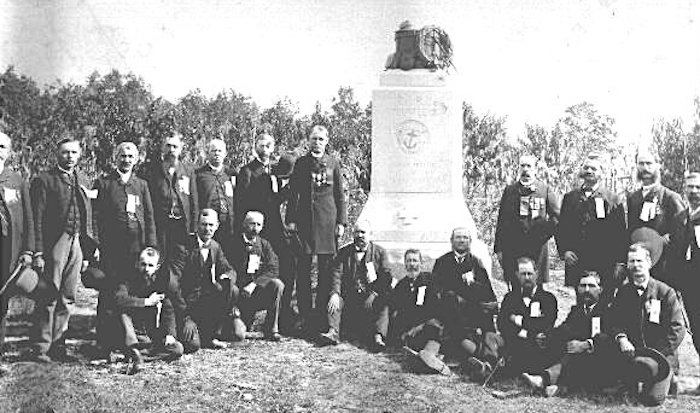
Lives in Peacedale eventually returned to normal. Other young men from town volunteered, fought, and returned. Some fought and died. In 1865, the war was over.
Lucy Adeline Smith married twice more, and lived until 1923. She is buried at Windham Cemetery in Windham, Connecticut. Nephew William E. Smith, who searched for and failed to find Esek at Bull Run, died in 1896 and was laid to rest not far from his young uncle's stone at Oak Dell.
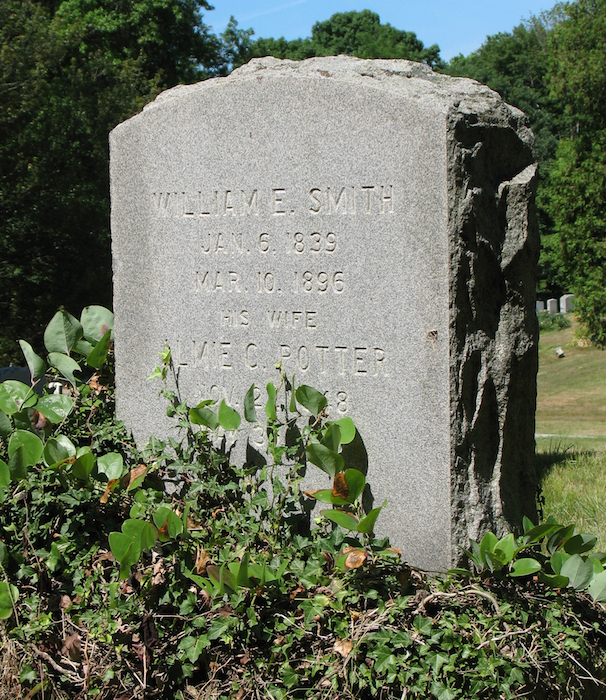
JAN. 6, 1839
MAR. 10, 1896
HIS WIFE
ALMIE C. POTTER
NOV. 27, 1843
MAY 30, 1917" (July 7, 2007).
Pawtucket resident Glenn V. Laxton, was an anchor, reporter, and assignment manager for WPRI TV 12 in Providence for more than forty years. At the time he wrote this article he was community affairs director for Channel 12 Eyewitness News. He was the co-author, with Paul F. Eno, of Rhode Island: A Genial History (2005), and author of Hidden History of Rhode Island: Not-to-Be-Forgotten Tales of the Ocean State (2009). Laxton passed away in June 2016. Esek B. Smith was his great-great-grandfather.